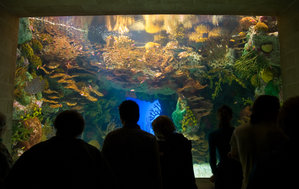
A tropical display tank at the
Georgia Aquarium
An aquarium (plural aquariums or aquaria)
is a
vivarium, usually contained in a clear-sided container
(typically constructed of glass or high-strength plastic) in
which water-dwelling plants and animals (usually
fish, and sometimes
invertebrates, as well as amphibians, marine mammals, and
reptiles) are kept in captivity, often for public
display; or it is an establishment featuring such displays.
Aquarium keeping is a popular hobby around the world, with
about 60 million enthusiasts worldwide. From the 1850s, when
the predecessor of the modern aquarium was first developed
as a novelty, the ranks of aquarists have swelled as more
sophisticated systems including lighting and filtration
systems were developed to keep aquarium fish healthy. Public
aquaria reproduce the home aquarist's hobby on a grand scale
— the Osaka Aquarium, for example, boasts a tank of 5,400 m³
(1.4 million U.S. gallons) and a collection of about 580
species of aquatic life, whilst the planned National
institute for research into aquatic habitats in England would be at 40-hectares the world's largest
aquarium.
A wide variety of aquaria are now kept by hobbyists,
ranging from a simple bowl housing a single fish to complex
simulated ecosystems with carefully engineered support
systems. Aquaria are usually classified as containing fresh
water or salt water and brackish water, at tropical or cold
water temperatures. These characteristics, and others,
determine the type of fish and other inhabitants that can
survive and thrive in the aquarium. Inhabitants for aquaria
are often collected from the wild, although there is a
growing list of organisms that are bred in captivity for supply to the
aquarium trade.
The careful aquarist dedicates considerable effort to
maintaining a tank ecology that mimics its inhabitants'
natural habitat. Controlling water quality includes managing
the inflow and outflow of nutrients, most notably the
management of waste produced by tank inhabitants. The
nitrogen cycle describes the flow of nitrogen from input via
food, through toxic nitrogenous waste produced by tank
inhabitants, to metabolism to less toxic compounds by
beneficial bacteria populations. Other components in maintaining a
suitable aquarium environment include appropriate species
selection, management of biological loading, and good
physical design. Failing to provide these conditions may
invite
Fish diseases.
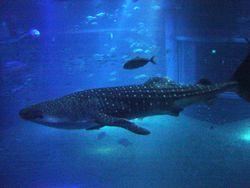
The main tank at
Osaka Aquarium houses a whale shark
History and development
Etymology
The word aquarium itself is taken directly from the latin
aqua, meaning water, with the suffix -rium,
meaning "place" or "building".
Ancient practices
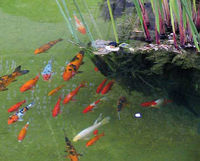
Koi have been kept in decorative ponds for
centuries in China and Japan.
The keeping of fish in confined or artificial
environments is a practice with deep roots in history.
Ancient
Sumerians were known to keep wild-caught fish in ponds,
before preparing them for meals. In China, selective
breeding of carp into today's popular koi and goldfish is
believed to have begun over 2,000 years ago. Depictions of
the sacred fish of Oxyrhynchus kept in captivity in
rectangular temple pools have been found in ancient Egyptian
art. Many other cultures also have a history of keeping fish
for both functional and decorative purposes. The Chinese
brought goldfish indoors during the Song dynasty to enjoy them in large ceramic vessels.
Glass enclosures
The concept of an aquarium, designed for the observation
of fish in an enclosed, transparent tank to be kept indoors,
emerged more recently. However, it is difficult to pinpoint
the exact date of this development. In 1665 the diarist
Samuel Pepys recorded seeing in London "a fine rarity, of
fishes kept in a glass of water, that will live so forever,
and finely marked they are, being foreign." The fish
observed by Pepys were likely to have been the paradise
fish, Macropodus opercularis, a familiar garden fish in
Guangzhou (Canton), China, where the East India Company was
then trading. In the 18th century, the biologist Abraham
Trembley kept hydra found in the garden canals of the
Bentinck residence 'Sorgvliet' in the Netherlands, in large cylindrical glass vessels for
study. The concept of keeping aquatic life in glass
containers, then, dates to at latest this period.
Popularization
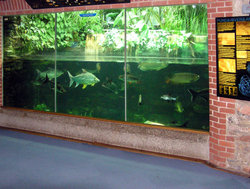
South East Asian fish in the aquarium at Bristol
Zoo, Bristol, England. The tank is about 2
meters (6 feet) high.
The keeping of fish in an aquarium first became a popular
hobby in
Britain only after ornate aquaria in cast-iron frames were
featured at the Great Exhibition of 1851. The framed-glass
aquarium was a specialized version of the glazed Wardian
case developed for British horticulturists in the 1830s to
protect exotic plants on long sea voyages. (One feature of
some 19th century aquaria that would prove curious to
hobbyists today was the use of a metal base panel so that
the aquarium water could be heated by flame.) Germans
rivaled the British in their interest, and by the turn of
the century Hamburg became the European port of entry for
many newly seen species. Aquaria became more widely popular
as houses became almost universally electrified after World
War I. With electricity great improvements were made in aquarium
technology, allowing artificial lighting as well as the
aeration, filtration, and heating of the water.
Popularization was also assisted by the availability of air
freight, which allowed a much wider variety of fish to be
successfully imported from distant regions of origin that
consequently attracted new hobbyists.
There are currently estimated to be about 60 million
aquarium hobbyists worldwide, and many more aquaria kept by
them. The hobby has the strongest following in Europe,
Asia, and North America. In the United States, a large minority (40%) of aquarists
maintain two or more tanks at any one time.
Function and design
From the outdoor ponds and glass jars of antiquity,
modern aquaria have evolved into a wide range of specialized
systems. Aquaria can vary in size from a small bowl large
enough for a single small fish, to the huge public aquaria
that can simulate entire marine
ecosystems. The most successful aquaria, as judged by
the long-term survivability of its inhabitants, carefully
emulate the natural environments that their residents would
occupy in the wild.
Freshwater aquaria remain the most popular due to their
lower cost and easier maintenance, but
marine (saltwater) aquaria have gained cachet as
dedicated enthusiasts prove it is possible to preserve these
challenging environments.
Design
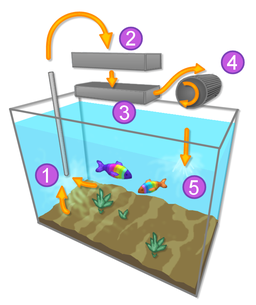
Filtration system in a typical aquarium: (1)
Intake. (2) Mechanical filtration. (3) Chemical
filtration. (4) Biological filtration medium.
(5) Outflow to tank.
The common freshwater aquarium maintained by a home
aquarist typically includes a filtration system, an
artificial lighting system, air pumps, and a heater. In
addition, some freshwater tanks (and most saltwater tanks)
use powerheads to increase water circulation.
Combined biological and mechanical filtration systems are
now common; these are designed to remove potentially
dangerous build up of nitrogenous wastes and
phosphates dissolved in the water, as well as particulate
matter. Filtration systems are the most complexly engineered
component of most home aquaria, and various designs are
used. Most systems use pumps to remove a small portion of
the tank's water to an external pathway where filtration
occurs; the filtered water is then returned to the aquarium.
Protein skimmers, filtration devices that remove proteins and other waste from the water, not only work
in Marine aqauriums but also work in nutrient rich
environments, but are made popular through the use of the
Berlin System.
Air pumps are employed to adequately oxygenate (or in the
case of a heavily planted aquarium, provide carbon dioxide
to) the water. These devices, once universal, are now
somewhat less commonly used as some newer filtration systems
create enough surface agitation to supply adequate gas
exchange at the surface. Aquarium heaters are designed to
act as
thermostats to regulate water temperature at a level
designated by the aquarist when the prevailing temperature
of air surrounding the aquarium is below the desired water
temperature. Coolers are also available for use in cold
water aquaria or in parts of the world where the ambient
room temperature is above the desired tank temperature.
An aquarium's physical characteristics form another
aspect of aquarium design. Size, lighting conditions,
density of floating and rooted plants, placement of
bogwood, creation of caves or overhangs, type of substrate, and other factors (including an aquarium's
positioning within a room) can all affect the behavior and
survivability of tank inhabitants.
The combined function of these elements is to maintain
appropriate water quality and characteristics suitable for
the aquarium's residents.
Classifications
Aquaria can be classified by several variables that
determine the type of aquatic life that can be suitably
housed. The conditions and characteristics of the water
contained in an aquarium are the most important
classification criteria, as most aquatic life will not
survive even limited exposure to unsuitable water
conditions. The size of an aquarium also limits the aquarist
in what types of ecosystems he can reproduce, species
selection, and biological loading.
Water conditions
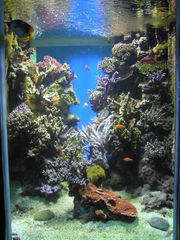
A saltwater aquarium
The solute content of water is perhaps the most important
aspect of water conditions, as total dissolved solids and
other constituents can dramatically impact basic water
chemistry, and therefore how organisms are able to interact
with their environment. Salt content, or salinity, is the
most basic classification of water conditions. An aquarium
may have fresh water (a salt level of < 0.5 PPT), simulating
a lake or river environment; brackish water (a salt level of
0.5 to 30 PPT), simulating environments lying between fresh
and salt, such as estuaries; and salt water or sea water (a salt level of 30 to 40 PPT), simulating an
ocean or sea environment. Rarely, even higher salt
concentrations are maintained in specialized tanks for
raising brine organisms.
Several other water characteristics result from dissolved
contents of the water, and are important to the proper
simulation of natural environments. The pH of the water is a
measure of the degree to which it is alkaline or acidic.
Saltwater is typically alkaline, while the pH of fresh water
varies more. Hardness measures overall dissolved mineral
content; hard or soft water may be preferred. Dissolved
organic content and dissolved gases content
are also important factors.
Home aquarists typically use modified tap water supplied
through their local water supply network to fill their
tanks. For freshwater aquaria, additives formulated to
remove chlorine or chloramine (used to disinfect drinking water supplies for human consumption)
are often all that is needed to make the water ready for
aquarium use.
Brackish or saltwater aquaria require the addition of a
mixture of salts and other minerals, which are commercially
available for this purpose.
More sophisticated aquarists may make other modifications
to their base water source to modify the water's alkalinity,
hardness, or dissolved content of organics and gases, before
adding it to their aquaria. There are two processes used for
that:
deionization or reverse osmosis. In contrast, public aquaria with large
water needs often locate themselves near a natural water
source (such as a river, lake, or ocean) in order to have
easy access to a large volume of water that does not require
much further treatment.
Secondary water characteristics
Secondary water characteristics are also important to the
success of an aquarium. The temperature of the water forms
the basis of one of the two most basic aquarium
classifications: tropical vs. cold water. Most fish and plant species tolerate only a
limited range of water temperatures: Tropical or warm water
aquaria, with an average temperature of about 25 °C (77 °F),
are much more common, and
tropical fish are among the most popular aquarium
denizens. Cold water aquaria are those with temperatures
below what would be considered tropical; a variety of fish
are better suited to this cooler environment.
Water movement can also be important in accurately
simulating a natural ecosystem. Aquarists may prefer
anything from still water up to swift simulated
currents in an aquarium, depending on the conditions
best suited for the aquarium's inhabitants.
Water temperature can be regulated with a combined
thermometer/heater unit (or, more rarely, with a cooling
unit), while water movement can be controlled through the
use of powerheads and careful design of internal water flow
(such as location of filtration system points of inflow and
outflow).
Size
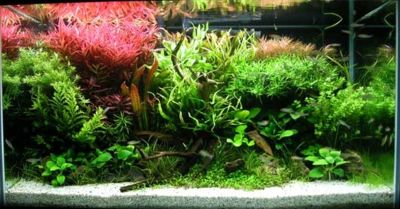
A planted freshwater aquarium.
An aquarium can range from a small, unadorned glass bowl
containing less than a litre of water – although generally
unsuited for most fish - to immense tanks built in public
aquaria which are limited only by engineering constraints
and can house entire ecosystems as large as kelp forests or
species of large sharks. In general, larger aquarium systems
are typically recommended to hobbyists due to their
resistance to rapid fluctuations of temperature and pH,
allowing for greater system stability.
Aquaria kept in homes by hobbyists can be as small as 3
U.S. gallons (11 L). This size is widely considered the
smallest practical system with filtration and other basic
systems; indeed, the local government of Rome, Italy, has
recently taken the step of banning traditional goldfish
bowls as inhumane. Practical limitations, most notably the
weight (fresh water weighs about 8.3 pounds per U.S. gallon
(1 kg/L), and salt water is even denser) and internal water
pressure (requiring thick, strong glass siding) of
a large aquarium, keep most home aquaria to a maximum of
around 1 m³ (300 U.S. gallons). However, some dedicated
aquarists have been known to construct custom aquaria of up
to several thousand U.S. gallons (several cubic meters), at
great effort and expense.
Public aquaria designed for exhibition of large species
or environments can be dramatically larger than any home
aquarium. The Shedd Aquarium features an individual aquarium
of two million U.S. gallons (19,000 m³), as well as two
others of 400,000 U.S. gallons (1,500 m³). The Monterey Bay
Aquarium has an acrylic viewing window into their largest
tank. At 56 feet long by 17 feet high (17 by 5 m), it used
to be the largest window in the world and is over 13 inches
(330 mm) thick. The Okinawa Churaumi Aquarium is the world's
second largest aquarium and part of the Ocean Expo Park (see
Expo
'75) located in Motobu, Okinawa. Its main tank,
which holds 7,500 cubic meters of water, features the
world's largest acrylic panel measuring 8.2 meters by 22.5
meters with a thickness of 60 centimeters. The size of
public aquaria are usually limited by cost considerations.
Species selection
Several theories on species selection circulate within
the community of hobby aquarists. Perhaps the most popular
of these is the division of aquaria into either a
community or aggressive tank type. Community
tanks house several species that are not aggressive toward
each other. This is the most common type of hobby aquarium
kept today. Aggressive tanks, in contrast, house a limited
number of species that can be aggressive toward other fish,
or are able to withstand aggression well. In both of these
tank types, the aquarium cohabitants may or may not
originate from the same geographic region, but generally
tolerate similar water conditions. In addition to the fish,
invertebrates, aquatic plants, and decorations or "aquarium
furniture" (all of which may or may not be natural
neighbors of any of the fish) are typically added to these
tank types.
Species or specimen tanks usually only
house one fish species, along with plants, perhaps found in
the fishes' natural environment and decorations simulating a
true ecosystem. These tanks are often used for
killifish, livebearers, cichlids etc. They can be simple as bare bottom with a
few necessities or a complex planted aquarium. Some tanks of
this sort are used simply to house adults for breeding. Such
tanks are common in fishrooms, where people keep many tanks
at home.
Ecotype or ecotope aquaria attempt to
simulate a specific ecosystem found in the natural world,
bringing together fish, invertebrate species, and plants
found in that ecosystem in a tank with water conditions and
decorations designed to simulate their natural environment.
These ecotype aquaria might be considered the most
sophisticated hobby aquaria; indeed, reputable public
aquaria all use this approach in their exhibits whenever
possible. This approach best simulates the experience of
observing an aquarium's inhabitants in the wild, and also
usually serves as the healthiest possible artificial
environment for the tank's occupants.
Species selection for saltwater
aquaria
In addition to the types above, a special category of
saltwater aquaria is the
reef aquarium. These aquaria attempt to simulate the complex
reef ecosystems found in warm, tropical oceans around the
world. These aquaria focus on the rich diversity of
invertebrate life in these environments, and typically
include only a limited number of small fish. Techniques of
maintaining sea anemones, some corals,
live rock,
mollusks, and crustaceans, developed since the 1980s, have made the
recreations of a reef ecosystem possible. Reef aquaria are
widely considered the most difficult and demanding of the
common hobbyist aquarium types, requiring the most expertise
in addition to the most specialized equipment (and
corresponding high cost).
Source of aquarium inhabitants

A
surface supplied diver interacts
with viewers while feeding the fish
|
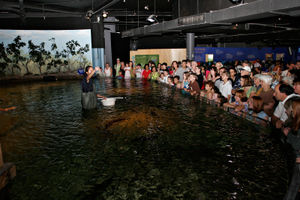
Feeding time at the Melbourne Aquarium
draws a large crowd
|
Fish and plants for the first modern aquaria were
gathered from the wild and transported (usually by ship) to
European and American ports. During the early 20th century
many species of small colorful
tropical fish were caught and exported from
Manaus, Brazil; Bangkok, Thailand; Jakarta, Indonesia; the
Netherlands Antilles; Kolkata, India; and other tropical ports. Collection of fish,
plants, and invertebrates from the wild for supply to the
aquarium trade continues today at locations around the
world. In many places of the world, impoverished local
villagers collect specimens for the aquarium trade as their
prime means of income. It remains an important source for
many species that have not been successfully bred in
captivity, and continues to introduce new species to
enthusiastic aquarists.
The practice of collection in the wild for eventual
display in aquaria has several disadvantages. Collecting
expeditions can be lengthy and costly, and are not always
successful. The shipping process is very hazardous for the
fish involved;
mortality rates are high. Many others are weakened by stress
and become diseased upon arrival. Fish can also be injured
during the collection process itself, most notably during
the process of using cyanide to stun reef fish to make them easier to
collect.
More recently, the potentially detrimental environmental
impact of fish and plant collecting has come to the
attention of aquarists worldwide. These include the
poisoning of coral reefs and non-target species, the
depletion of rare species from their natural habitat, and
the degradation of ecosystems from large scale removal of
key species. Additionally, the destructive fishing
techniques used have become a growing concern to
environmentalists and hobbyists alike. Therefore, there has
been a concerted movement by many concerned aquarists to
reduce the trade's dependence on wild-collected specimens
through captive breeding programs and certification programs
for wild-caught fish. Among American keepers of marine aquaria surveyed in 1997, two
thirds said that they prefer to purchase farm raised coral
instead of wild-collected coral, and over 80% think that
only sustainably caught or captive bred fish should be
allowed for trade.
Since the Siamese Fighting Fish (Betta splendens) was
first successfully bred in France in 1893, captive spawning
techniques have been slowly discovered. Captive breeding for
the aquarium trade is now concentrated in southern Florida,
Singapore, Hong Kong, and Bangkok, with smaller industries
in Hawaii and Sri Lanka. Captive breeding programs of marine
organisms for the aquarium trade have been
urgently in development since the mid-1990s. Breeding
programs for freshwater species are comparatively more
advanced than for saltwater species.
Aquaculture is the cultivation of aquatic organisms in a
controlled environment. Supporters of aquaculture programs
for supply to the aquarium trade claim that well-planned
programs can bring benefits to the environment as well as
the society around it. Aquaculture can help in lessening the
impacts on wild stocks, either by using raised cultivated
organisms directly for sale or by releasing them to
replenish wild stock, although such a practice is associated
with several environmental risks.
A downside of the aquarium fish trade has been its role
as a source of invasive fish and aquatic plant species.
Exotic fish and aquatic plant species have been established
in countries outside of their origin by irresponsible tank
owners releasing their exotic fish or emptying their tank
contents into rivers and streams, which in some cases have
posed a threat to native species and ecosystems.
Ecology
Ideal aquarium
ecology reproduces the balance found in nature in the closed
system of an aquarium. In practice it is virtually
impossible to maintain a perfect balance. As an example, a
balanced predator-prey relationship is nearly impossible to
maintain in even the largest of aquaria. Typically an
aquarium keeper must take steps to maintain balance in the
small ecosystem contained in his aquarium.
Approximate balance is facilitated by large volumes of
water. Any event that perturbs the system pushes an aquarium
away from equilibrium; the more water that is contained in a
tank, the easier such a
systemic shock is to absorb, as the effects of that
event are diluted. For example, the death of the only fish
in a three U.S. gallon tank (11 L) causes dramatic changes
in the system, while the death of that same fish in a 100
U.S. gallon (400 L) tank with many other fish in it
represents only a minor change in the balance of the tank.
For this reason, hobbyists often favor larger tanks when
possible, as they are more stable systems requiring less
intensive attention to the maintenance of equilibrium.
Nitrogen cycle
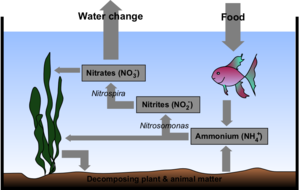
The nitrogen cycle in an aquarium.
Of primary concern to the aquarist is management of the
biological
waste produced by an aquarium's inhabitants. Fish,
invertebrates, fungi, and some bacteria excrete nitrogen
waste in the form of ammonia (which may convert to ammonium,
depending on water chemistry) which must then pass through
the nitrogen cycle. Ammonia is also produced through the
decomposition of plant and animal matter, including fecal
matter and other detritus. Nitrogen waste products become
toxic to fish and other aquarium inhabitants at high
concentrations.
A well-balanced tank contains organisms that are able to
metabolize the waste products of other aquarium residents.
The nitrogen waste produced in a tank is metabolized in
aquaria by a type of bacteria known as nitrifiers (genus
Nitrosomonas). Nitrifying bacteria capture ammonia from the
water and metabolize it to produce nitrite. Nitrite is also
highly toxic to fish in high concentrations. Another type of
bacteria, genus Nitrospira, converts nitrite into nitrate, a
less toxic substance to aquarium inhabitants. (Nitrobacter
bacteria were previously believed to fill this role, and
continue to be found in commercially available products sold
as kits to "jump start" the nitrogen cycle in an aquarium.
While biologically they could theoretically fill the same
niche as Nitrospira, it has recently been found that
Nitrobacter are not present in detectable levels in
established aquaria, while Nitrospira are plentiful.) This
process is known in the aquarium hobby as the nitrogen
cycle.
In addition to bacteria, aquatic plants also eliminate
nitrogen waste by metabolizing ammonia and nitrate. When
plants metabolize nitrogen compounds, they remove nitrogen
from the water by using it to build
biomass. However, this is only temporary, as the plants
release nitrogen back into the water when older leaves die
off and decompose.
Although informally called the
nitrogen cycle by hobbyists, it is in fact only a
portion of a true cycle: nitrogen must be added to the
system (usually through food provided to the tank
inhabitants), and nitrates accumulate in the water at the
end of the process, or become bound in the biomass of
plants. This accumulation of nitrates in home aquaria
requires the aquarium keeper to remove water that is high in
nitrates, or remove plants which have grown from the
nitrates.
Aquaria kept by hobbyists often do not have the requisite
populations of bacteria needed to detoxify nitrogen waste
from tank inhabitants. This problem is most often addressed
through two filtration solutions: Activated carbon filters
absorb nitrogen compounds and other toxins from the water,
while biological filters provide a medium specially designed
for colonization by the desired nitrifying bacteria.
New aquariums often have problems associated with the
nitrogen cycle due to insufficient number of beneficial
bacteria. Therefore new tanks have to be "matured" before
stocking them with fish. There are two basic approaches to
this: the fishless cycle and the silent cycle.
No fish are kept in a tank undergoing a fishless cycle.
Instead, small amounts of ammonia are added to the tank to
feed the bacteria being cultured. During this process,
ammonia, nitrite, and nitrate levels are tested to monitor
progress. The silent cycle is basically nothing more than
densely stocking the aquarium with fast-growing aquatic
plants and relying on them to consume the nitrogen, allowing the necessary bacterial populations
time to develope. According to anecdotal reports of
aquarists specializing in planted tanks, the plants can
consume nitrogenous waste so efficiently that the spikes in
ammonia and nitrite levels normally seen in more traditional
cycling methods are greatly reduced, if they are detectable
at all.
The largest bacterial populations in a tank are found in
the filter. Therefore efficient filtration is vital. A
vigorous cleaning of the filter is sometimes enough to
seriously disturb the biological balance of an aquarium.
Other nutrient cycles
Nitrogen is not the only nutrient that cycles through an
aquarium. Dissolved oxygen enters the system at the surface
water-air interface or through the actions of an air pump.
Carbon dioxide escapes the system into the air. The
phosphate cycle is an important, although often overlooked,
nutrient cycle. Sulfur, iron, and micronutrients also cycle
through the system, entering as food and exiting as waste.
Appropriate handling of the nitrogen cycle, along with
supplying an adequately balanced food supply and considered
biological loading, is usually enough to keep these other
nutrient cycles in approximate equilibrium.
Biological loading
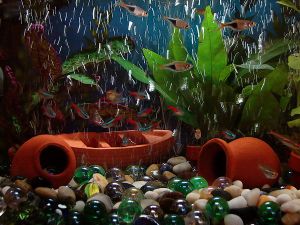
19 Liter Aquarium, seems to be overcrowded
Biological loading is a measure of the burden placed on
the aquarium ecosystem by its living inhabitants. High
biological loading in an aquarium represents a more
complicated tank ecology, which in turn means that
equilibrium is easier to perturb. In addition, there are
several fundamental constraints on biological loading based
on the size of an aquarium. The
surface area of water exposed to air limits dissolved oxygen
intake by the tank. The capacity of
nitrifying bacteria is limited by the physical space they
have available to colonize. Physically, only a limited size
and number of plants and animals can be fit into an aquarium
while still providing room for movement.
In order to prevent biological overloading of the system,
aquarists have developed a number of
rules of thumb. Perhaps the most popular of these is the
"7mm per liter of water" which dictates that the sum in cm
of the lengths of all fish kept in an aquarium (excluding
tail length) should not exceed the capacity of the tank
measured in Liters (one inch of fish per U.S. gallon). This
rule is usually applied to the expected mature size of the
fish, in order to not stunt growth by overcrowding, which
can be unhealthy for the fish. (Note that this rule of thumb
breaks down for thick bodied fishes like some catfish, and
aggressive fish like most Cichlids.) For goldfish and other high-waste fish, many aquarists
recommend doubling the space allowance to one inch of fish
per every two gallons and others even debate the usefulness
of the "inch per gallon" rule because if fails to consider
other important issues such as fish temperament, activity,
compatibility with other tank mates(i.e. two male bettas
shouldn't be kept together) dimensions of aquarium, and the
filtration capabilities of the aquarium. The safest method
of determining the stocking limits and compatibility is to
talk to an experienced aquarist or group of aquarists at a
local organization or a dedicated online forum.
The true maximum or ideal biological loading of a system
is very difficult to calculate, even on a theoretical level.
To do so, the variables for waste production rate,
nitrification efficiency, gas exchange rate at the water
surface, and many others would need to be determined. In
practice this is a very complicated and difficult task, and
so most aquarists use rules of thumb combined with a trial
and error approach to reach an appropriate level
of biological loading.
Public aquaria
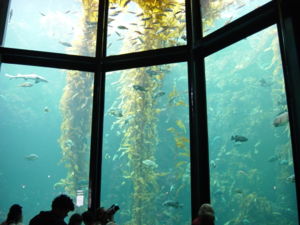
A 335,000 U.S. gallon (1.3 million liter)
aquarium at the
Monterey Bay Aquarium in California displaying a
simulated kelp forest ecosystem
Public aquaria are facilities open to the public for
viewing of aquatic species in aquaria. Most public aquaria
feature a number of smaller tanks, as well as one or more
tanks greater in size than could be kept by any home
aquarist. The largest tanks hold millions of U.S. gallons of
water and can house large species, including
dolphins, sharks or beluga whales. Aquatic and semiaquatic
animals, including otters and penguins, may also be kept by public aquaria.
Operationally, a public aquarium is similar in many ways
to a zoo or museum. A good aquarium will have special
exhibits to entice repeat visitors, in addition to its
permanent collection. A few have their own version of a
"petting zoo"; for instance, the Monterey Bay Aquarium has a
shallow tank filled with common types of rays, and one can reach in to feel their leathery skins
as they pass by.
Also as with zoos, aquaria usually have specialized
research staff who study the habits and biology of their
specimens. In recent years, the large aquaria have been
attempting to acquire and raise various species of
open-ocean fish, and even jellyfish (or sea-jellies,
cnidaria), a difficult task since these creatures have never
before encountered solid surfaces like the walls of a tank,
and do not have the instincts to turn aside from the walls instead of
running into them.
The first public aquarium opened in London's Regent's
Park in 1853. P.T. Barnum quickly followed with the first
American aquarium, opened on Broadway in New York. Following
early examples of Detroit, New York, Philadelphia and San
Francisco, many major cities now have public
aquaria.
Most public aquaria are located close to the
ocean, for a steady supply of natural seawater. An inland
pioneer was Chicago's Shedd Aquarium that received seawater
shipped by rail in special tank cars. The early (1911)
Philadelphia Aquarium, built in the city's disused water
works, ironically had to switch to treated city water when
the nearby river became too contaminated. Similarly, the
recently opened Georgia Aquarium filled its tanks with fresh water from
the city water system and salinated its salt water exhibits
using the same commercial salt and mineral additives
available to home aquarists.
In January 1985 Kelly Tarlton began construction of the
first aquarium to include a large transparent acrylic tunnel
in Auckland, New Zealand, a task that took 10 months and
cost NZ$3 million. The 110-meter tunnel was built from
one-tonne slabs of German sheet plastic that were shaped
locally in an oven. A moving walkway now transports visitors
through, and groups of school children occasionally hold
sleepovers there beneath the swimming sharks and rays.
Top public aquaria are often affiliated with important
oceanographic research institutions or conduct their own
research programs, and usually (though not always)
specialize in species and ecosystems that can be found in
local waters.
See also
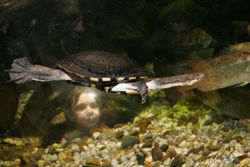
A little girl looks into an aquarium, Melbourne
Aquarium
References
Internet references
Book and journal references
- Brunner, Bernd (2005). The Ocean at Home: An
Illustrated History of the Aquarium. New York:
Princeton Architectural Press.
ISBN 1-56898-502-9.
- Scott, Peter W (1995). The Complete Aquarium.
DK Publishing.
ISBN 0-7894-0013-8.
- Skomal, Gregory (1997). Setting up a
Freshwater Aquarium: An Owner's Guide to a Happy
Healthy Pet. New York: Wiley Publishing.
ISBN 0-87605-502-1.
- Tlusty, Michael (2002). The benefits and
risks of aquaculture production for the aquarium
trade. Aquaculture. v205 i3 pg 203(17).
External links




